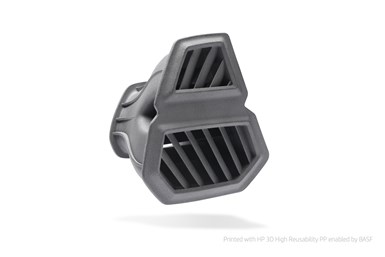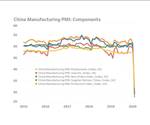The New Normal? Resilient Supply Chains with 3D Printing
We were already headed toward expanded adoption of 3D printing, in HP’s view, when the coronavirus hit. The pandemic’s disruption will only get us there faster.
The pandemic hasn’t slowed or derailed the adoption of 3D printing, in HP’s view. Instead, it has been an accelerator. Photos: HP
In a press briefing held June 3, HP’s Ramon Pastor, interim director of its 3D printing and digital manufacturing business, called the coronavirus pandemic a “watershed moment” for additive manufacturing (AM).
He was referring not only to 3D printing’s response to calls for PPE and testing swabs, but also to how and why this technology came to be applied for these items. Where the conventional supply chain broke down, 3D printing was able to step in, rapidly develop and earn approval for designs, distribute part files, and get production moving not in months and years, but days and weeks — timelines “previously unheard of” for healthcare. Simultaneously, AM was being applied to produce other needed items in supply chains not directly related to the pandemic, but disrupted by it all the same.
“The pandemic has been an accelerant for the trajectory of the industry.”
“The pandemic has been an accelerant for the trajectory of the industry,” Pastor says. “During this time, additive manufacturing did one of two things: it enabled companies to keep their existing production operational or it allowed them to pivot to creating essential products.” But, he points out, “The ability to do either of those things with 3D printing existed before COVID-19, so it is not a change of course. What it is, is a proof point like no other.”
3D Printing Will Shore Up Supply Chains in the New Normal

Ramon Pastor leads HP’s 3D Printing and Digital Manufacturing business as interim president.
The lessons learned from this crisis period will not end with the flattening of the curve; HP expects that processes and knowledge proved out as a result of coronavirus will inform and shape the future of manufacturing.
“We have seen the limits of the traditional supply chain,” as a result of this crisis Pastor says. “Now, we morph to the ‘new normal times’ knowing and realizing what we have accomplished will inform a new way to work — and not just in medical.” The test now, he says, is to build resilient supply chains that, yes, can benefit from 3D printing.
“Prior to COVID-19, much of the supply chain conversation and the evolution toward digital supply chains was focused on efficiency and transparency,” Pastor says. “Those priorities have not gone away; in fact, they are more important than ever. But another element has now come to the forefront of supply chain transformation, and that is risk mitigation. 3D printing has been so important in this crisis is because it is inherently digital, localized and sustainable, making it more immune to economic or geopolitical volatility. ”
New Services Support Scaling with Additive Manufacturing
Several of the company’s new technology announcements and business developments speak to this, with new services for manufacturers who are perhaps turning to additive for the first time, having seen its flexible, agile response during the crisis. HP has introduced a suite of 3D Professional Services to help AM users of all levels quickly scale to production.
At the initial adoption level, a digital Parts Assessment tool and consulting services will help customers analyze and identify which parts may be candidates for the company’s Multi Jet Fusion (MJF) polymer 3D printing technology. Design for additive manufacturing (DFAM) training will also be available. For users ready to develop their AM applications, HP offers design optimization as well as services to build out postprocessing procedures, quality assurance and other processes. When manufacturers are at the moment of moving into volume production, they can utilize HP expertise to work with their suppliers or develop an in-house production process if vertically integrated.

Applications for Multi Jet Fusion in the automotive space, such as this door defroster, are expected to expand with the introduction of HP 3D High Reusability PP enabled by BASF.
At a partnership level, HP also announced new and expanded relationships during the June 3 call. The company is working with Germany-based Oeschler to prove out new applications for its technologies in the automotive, home and medical spaces. Chicago-based service bureau Fast Radius has joined the Distributed Manufacturing Network, a collection of production-scale 3D printing companies that provide manufacturing services. And HP’s ongoing collaboration with materials manufacturer BASF has resulted in a new polymer material for MJF, polypropylene (PP).
“The current pandemic will not be the last profound global challenge we face.”
But as additive manufacturing marches forward, HP’s focus is not just on increasing applications and material options. It sees 3D printing not in a vacuum, but as part of an interconnected and dynamic ecosystem.
“The current pandemic will not be the last profound global challenge we face,” Pastor says. Being resilient in the face of future emergencies will not only mean having duplicate facilities or redundant resources; supply chains will also need to rely on production assets that are flexible and agile, a role that digital and additive manufacturing can fill.
Related Content
Large-Format “Cold” 3D Printing With Polypropylene and Polyethylene
Israeli startup Largix has developed a production solution that can 3D print PP and PE without melting them. Its first test? Custom tanks for chemical storage.
Read MoreVulcanForms Is Forging a New Model for Large-Scale Production (and It's More Than 3D Printing)
The MIT spinout leverages proprietary high-power laser powder bed fusion alongside machining in the context of digitized, cost-effective and “maniacally focused” production.
Read MoreAluminum Gets Its Own Additive Manufacturing Process
Alloy Enterprises’ selective diffusion bonding process is specifically designed for high throughput production of aluminum parts, enabling additive manufacturing to compete with casting.
Read MoreMultimaterial 3D Printing Enables Solid State Batteries
By combining different 3D printing processes and materials in a single layer, Sakuu’s Kavian platform can produce batteries for electric vehicles and other applications with twice the energy density and greater safety than traditional lithium-ion solutions.
Read MoreRead Next
Why HP Believes in 3D Printing
The reasons go beyond the world of manufacturing. Ramon Pastor, global head of plastics solutions for 3D Printing and Digital Manufacturing, shares the four macrotrends at the foundation of HP’s 3D printing business.
Read MoreIn Coronavirus Uncertainty, 3D Printing Is a Potential Solution for U.S. Manufacturing
The impact of the COVID-19 virus has reached U.S. manufacturers by way of the supply chain. Here are several ways 3D printing could help, plus a video discussion of the data with economist Michael Guckes.
Read More3D Printing Brings Sustainability, Accessibility to Glass Manufacturing
Australian startup Maple Glass Printing has developed a process for extruding glass into artwork, lab implements and architectural elements. Along the way, the company has also found more efficient ways of recycling this material.
Read More
.jpg;width=70;height=70;mode=crop)




















